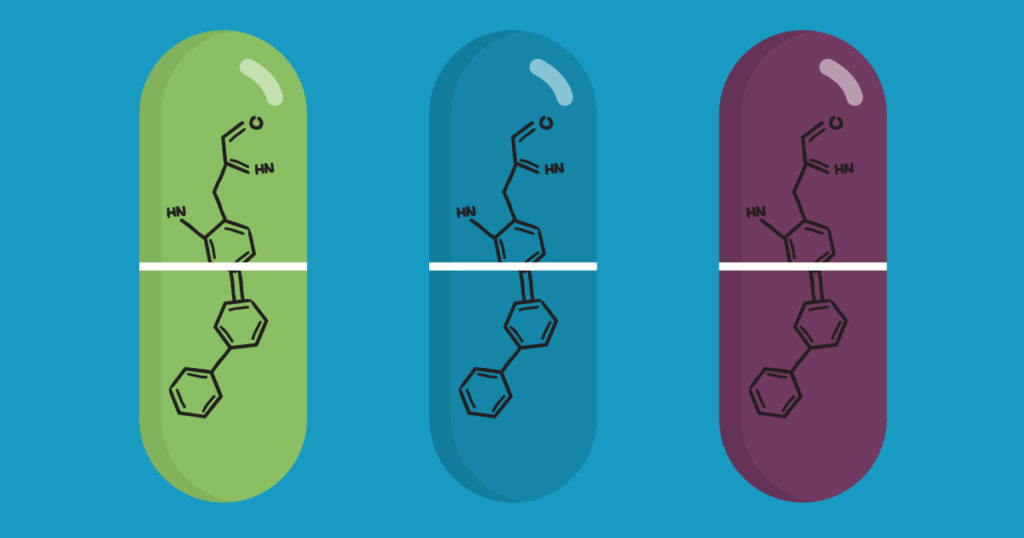This blog was written by guest author, Amy Landreman, PhD.
Drug repurposing, identifying new uses for approved or investigational drugs, is an attractive strategy when looking for new disease treatments. Because the compounds have already gone through some level of pre-clinical optimization and safety testing, this approach can reduce risk, reduce cost, and speed up the timeline for further drug development. An additional benefit of this approach is that it can result in new biological insights or a better understanding of disease mechanisms since these compounds usually already have some level of mechanistic characterization. Indeed, there are now a number of compound collections openly available specifically for the purpose of facilitating drug repurposing efforts. For example, the ReFRAME (Repurposing, Focused Rescue, and Accelerated Medchem) library is a collection of 12,000 compounds developed by Scripps Research Center and has been screened to identify novel candidate therapeutics for Cryptosporidium infection (1). The Broad Institute also offers a drug repurposing hub that contains an annotated collection of over 7,000 compounds.

Drug repurposing libraries, although often smaller than novel compound small molecule libraries, are designed for implementation into high-throughput screening workflows in order to efficiently triage compounds for the desired result. Effective compound screens require assays that can be scaled to 384 or 1536-well microplate formats and implemented in batch or continuous processing workflows. The firefly luciferase reaction has been leveraged to create many assays that are well-suited to these types of high-throughput screening approaches. In particular, the generation of “Glow” assays that have stable luminescent signals and homogenous assay design is a good fit. The signal stability allows for multi-plate processing and because the reagent is added directly to cells in culture, pre-processing steps are eliminated allowing for automated workflows. Assay reagents such as the CellTiter-Glo® Cell Viability Assay and the ADP-Glo™ Kinase Assay are commonly used in screening efforts including those done with repurposing libraries. In addition, there are several firefly luciferase reporter assay reagents such as Steady-Glo® and Bright-Glo™ Luciferase Assays that have been optimized for high-throughput detection of firefly luciferase activity making them well-suited to repurposing screens.

Case study: Drug Repurposing Screen to Identify SARS-CoV-2 Entry Inhibitors
The global pandemic of COVID-19 caused by SARS-CoV-2 virus created a situation that highlighted a key advantage of drug repurposing screens, significantly reduced turnaround time by studying compounds that are already characterized. The urgency of the situation meant there was no time to waste in identifying potential treatment strategies. One group of researchers at NCATs and Ithaca university teamed uptake on this challenge with the goal of identifying compounds that could block the entry of SARS-CoV-2 into cells (2). In this effort, they utilized the NCATS pharmaceutical collection (NPC), which is a collection of nearly 3000 compounds, representing approved or investigational drugs. These researchers used SARS-S and MERS-S firefly luciferase reporter pseudotyped viruses that expressed the spike proteins (S) responsible for host receptor binding. If the pseudovirus was able to successfully enter the host cell, a luciferase signal could be measured. However, if any of the compounds in the NPC library were able to block viral entry, the luciferase signal would be reduced. There are many choices for measuring luciferase-tagged reporter pseudotyped viral particles, and these researchers chose to use the Steady-Glo® reagent in their screen. They were able to miniaturize their assay into a 1536-plate format and carried out the initial screen at 4 concentrations for each compound. A counter screen for compound cytotoxicity as determined by ATP content assay (CellTiter-Glo) was also performed.
The initial screen resulted in 106 hits. After further screening and counter-screening efforts, six compounds (cepharanthine, abemaciclib, osimertinib, trimipramine, colforsin, and ingenol) were identified as broad-spectrum inhibitors for spike-mediated entry. Interestingly, two of the compounds, cepharanthine and abemaciclib, were already reported to have anti-SARS-CoV-2 effects, while the other 4 compounds were novel, presenting new insight into potential mechanisms that can inhibit viral entry.
Overall, the work done by this research team contributes to our collective knowledge in understanding how to develop effective treatments against the initial stage of coronavirus infection and provides mechanistic information that could aid the design of new drug combinations. The use of a repurposing screen allowed this research team to take advantage of the pre-existing work done to characterize the compounds in the NPC collection, providing a rapid route for new discovery.

To learn more about the last 30 years of bioluminescent innovations and the discoveries they’ve enabled, please visit our 30th anniversary celebration page.
References
- Janes et al. (2018)The ReFRAME library as a comprehensive drug repurposing library and its application to the treatment of cryptosporidiosis. PNAS 115(42) 10750–10755.
- Chen et al. (2020) Identifying SARS-CoV-2 Entry Inhibitors through Drug Repurposing Screens of SARS-S and MERS-S Pseudotyped Particles. ACS Pharmacol Transl Sci. 3(6):1165–1175

Amy is a Sr. Product Manager at Promega Corporation. Her primary responsibility is managing the product life cycle and new product roadmap for the bioluminescent reporter and transfection product areas. Her favorite part of this job is identifying unmet needs within the scientific community and communicating these needs across the organization to create useful new products. Amy received her BS degree in Botany and PhD in Molecular and Environmental Toxicology from the University of Wisconsin-Madison and worked as an applied toxicologist before transitioning to roles product technical support and product management.
Latest posts by Promega (see all)
- Overcoming qPCR Inhibitors: Strategies for Reliable Quantification - March 13, 2025
- Celebrating Creativity and Innovation: The 2025 Promega Employee Art Showcase - February 4, 2025
- Soft Skills for the Science Lab: Develop Yourself with Promega - November 14, 2024
